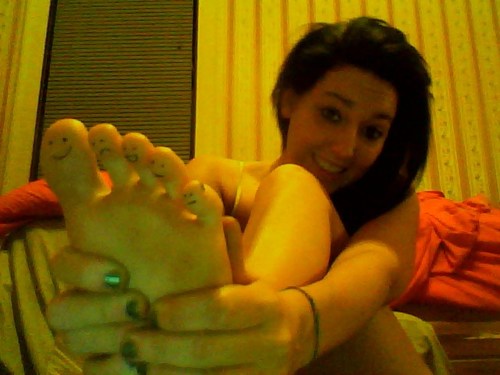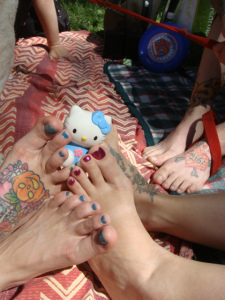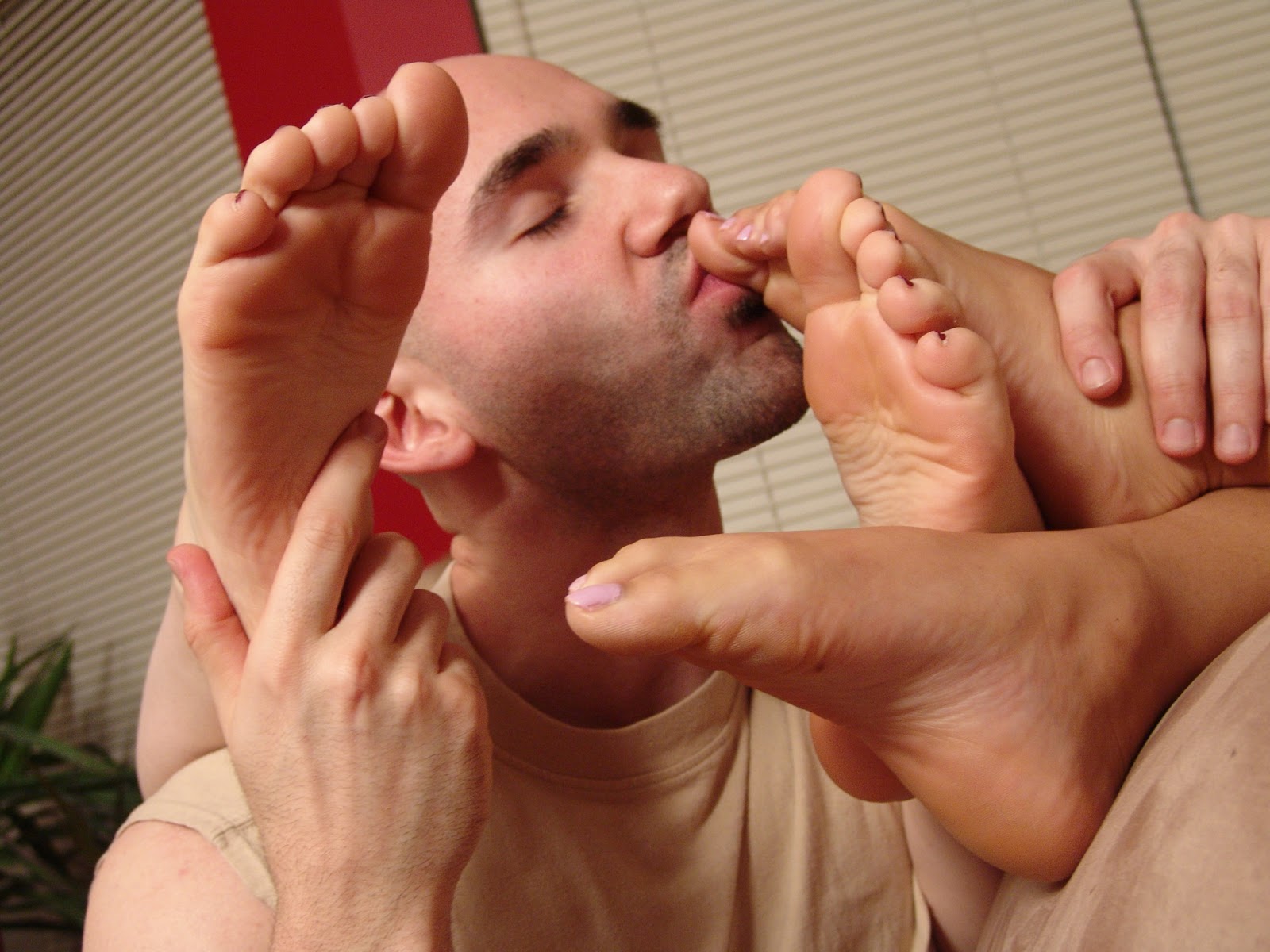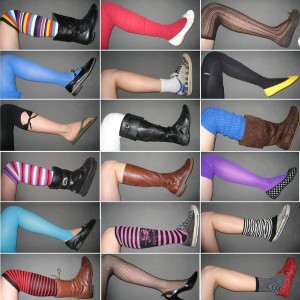The Allure of “Podophilia”: Why Some People Are Really Into Feet by JESSE BERING
Note: The following excerpt from Why Is the Penis Shaped Like That? And Other Reflections On Being Human (FSG/Scientific American) appeared originally in German in the 06.09.12 issue of the Swiss weekly Das Magazin. And was posted on Jesse’s website so thought id reblog here. So the main reason is because i was having a conversation with a family member after she asking someone on facebook to suck her toes. (You know who you are)
It’s easy to confuse the term with pedophilia, but let’s talk about podophilia, the love of feet and often, by extension, Shoes. Actually, there’s a fair share of podophiliac pedophiles, so it’s worth pointing out that the two are not mutually exclusive. But in any event, at the risk of veering off already into a fetish of an entirely different sort (acrotomophilia, which is the love of amputees or, more specifically, a lusting after their severed limbs), let me begin by saying that I’ve always found feet—those elongated, malodorous, beknuckled terrestrial hands—somehow awfully off-putting. Not that I’d prefer them snipped off my partners, but you know what I mean.
In fact, my own distaste for feet makes podophilia all the more intriguing to me because, among other things, it goes to show how receptive to learning our carnal taste buds may in fact be in contributing to what later becomes delectable. Perhaps my genitals only lacked a mysterious encounter with other people’s feet during a critical period of my sexual development. Many people who derive their primary sexual satisfaction from “foot play” can trace their fondness for feet to specific episodes either in their childhoods or during their early adolescence.
One of the most important and detailed historical treatments of the subject of foot (and shoe) fetishism is that by the British sexologist Havelock Ellis in 1927. “In a small but not inconsiderable minority of persons,” writes Ellis, “the foot or boot becomes the most attractive part of a woman, and in some morbid cases the woman herself is regarded as a comparatively unimportant appendage.” Ellis describes the case of the eighteenth-century French novelist Rétif de la Bretonne, whose irreverent literary works were filled with references to his own fancies. (In fact, the eponymous “retifism” is an arcane term for foot fetishism.) In Rétif’s very frank autobiography, Monsieur Nicolas, the then-sixty-year-old writer reminisces about being smitten with a girl’s feet as early as age four. Rétif’s theory about the origins of his foot fetish was that since feminine freshness and purity were so prized in his day, those ladies who managed to keep that part of their body which met directly with the dirt so delicate and unspoiled were the most attractive of all.
“This taste for the beauty of the feet,” reflects Rétif of his upbringing in the Burgundy region of France, “was so powerful in me that it unfailingly aroused desire … When I entered a house and saw the boots arranged in a row, as is the custom, I would tremble with pleasure; I blushed and lowered my eyes as if in the presence of the girls themselves.” What was especially arousing to Rétif, Ellis explains, was his knowledge that these objects had absorbed the essence of the feet he so desired. “He would kiss with rage and transport whatever had come in close contact with the woman he adored.” In fact, he wished desperately to be buried with the “green slippers with rose heels and borders” of an older woman whose feet he’d become infatuated with as a teenage boy.
More recent work has validated Ellis’s hunch that shoe fetishism is not simply a peculiar attraction to these inanimate objects and  that sexual arousal is related to the intimate connection with the feet of a particular shoe owner. For example, in a series of reports on male homosexual foot fetishism, the sociologist Martin Weinberg and his colleagues asked members of the Foot Fraternity what they found especially attractive in shoes. The majority of these 262 men expressed complete sexual disinterest in new, never-worn shoes. Instead, they had a clear preference for footwear that had been well-worn by a good-looking person. Shopping for shoes at thrift stores was a godsend for many of these fetishists, since it allowed them to fantasize about the original owner rather than face the ugly realties of an aesthetically challenged sole—soul, I mean soul. And just as heterosexual podophilia has a symbolic element, with straight connoisseurs displaying very particular tastes for certain styles of female footwear and leggings, gay foot fetishists associate shoe types with idealized males. One man, for example, explained to the investigators how a rich tapestry of senses had become linked to stereotypical associations with different male shoe types: “the odors and the corresponding image; docksiders and preppies, sneakers and young punks, boots and dominant men.” Other gay male foot fetishists repeated this symbolic theme in their likes and dislikes:
that sexual arousal is related to the intimate connection with the feet of a particular shoe owner. For example, in a series of reports on male homosexual foot fetishism, the sociologist Martin Weinberg and his colleagues asked members of the Foot Fraternity what they found especially attractive in shoes. The majority of these 262 men expressed complete sexual disinterest in new, never-worn shoes. Instead, they had a clear preference for footwear that had been well-worn by a good-looking person. Shopping for shoes at thrift stores was a godsend for many of these fetishists, since it allowed them to fantasize about the original owner rather than face the ugly realties of an aesthetically challenged sole—soul, I mean soul. And just as heterosexual podophilia has a symbolic element, with straight connoisseurs displaying very particular tastes for certain styles of female footwear and leggings, gay foot fetishists associate shoe types with idealized males. One man, for example, explained to the investigators how a rich tapestry of senses had become linked to stereotypical associations with different male shoe types: “the odors and the corresponding image; docksiders and preppies, sneakers and young punks, boots and dominant men.” Other gay male foot fetishists repeated this symbolic theme in their likes and dislikes:
“Boots represent power and strength … They exemplify the essence of manhood, an exaggeration of maleness.”
“Wing tips typify a successful businessman.”
“Sneakers have been in contact with a good-looking young stud.”
“Weejun penny loafers are worn by preppie college guys.”
In a subsequent article in The Journal of Sex Research, Weinberg and his colleagues returned to their foot fan base (the Foot Fraternity boasted more than a thousand members in 1995, the vast majority being well-educated white men with white-collar jobs) and asked these individuals to reflect in writing on the origins of their love of male feet. “We specifically asked the age at which respondents first became interested in feet/footwear,” explain the authors, “and, to tap the reinforcing effect of masturbation”—no pun intended, I don’t think—“their experiences with fantasies about feet/footwear when they masturbated during adolescence.” Fetishists reported a mean age of twelve in their first becoming (consciously) sexually aroused by feet, with nearly all of them masturbating regularly to foot-related objects (such as shoes or socks or photographs of feet) or to mental images of steamy podiatric encounters.
In terms of developmental milieu, many of the 204 respondents couldn’t recall a specific incident per se from their pasts that they might attribute to this now concretized aspect of their adult sexual identity. Yet 89 were able to give detailed accounts of their suspected first foot-related triggers. And for you parents out there with your toes dangling promiscuously for your impressionable young children to see, their answers might give you pause. “Sleeping upside down with my parents,” reflects one grown man of his early childhood and his snuggling innocently with them under the covers, “and finding my dad’s feet in my face.” “I used to tickle my dad’s feet,” recalls another. “I enjoyed his laughter very much … He would feign enjoyment as part of the game.” Another reminisces: “At about 5 or 6 years old, removing my father’s shoes and massaging his hot feet … The soft, warm feet and the pleasure he seemed to experience—usually going to sleep—and I could kiss and lick his feet.” Other respondents had similar experiences, but theirs were unrelated to parental feet. The foot of a hero-worshipped older brother hanging down in front of one’s face as he lay on a topmost bunk bed, for example, or wrestling playfully with one’s friends or neighbors and finding a foot buried, and not unpleasantly so, in one’s crotch.
As with Ellis’s analysis of heterosexual podophiles, Weinberg and his colleagues observed that the origins of this homosexual podophilia could almost always be traced back to such positive experiences during development, rather than negative or abusive ones. This is an important observation, in fact, because it’s often assumed that such a fetish represents the person’s masochistic desire to be kicked or violently tread upon. Although this is in some cases true, Ellis admonishes us not to so hastily assume that the average foot lover has a secret desire to be subservient to a dominant figure. “To suppose that a fetishistic admiration of his mistress’s foot is due to a lover’s latent desire to be kicked,” he proclaims, “is as unreasonable as it would be to suppose that a fetishistic admiration for her hand indicated a latent desire to have his ears boxed.”
Ellis was convinced that it’s often the most intelligent and precocious children who are particularly “liable to become the prey of a chance symbolism” in their sexual development, forever shaping their adult orientations. One especially vivid example of such a child, in this case a very troubled one, is laid out in the American Journal of Psychotherapy in an article titled “The Treatment of a Child Foot Fetishist.” A team of physicians led by Jules Bemporad handled the case. The boy, whom the psychiatrists called “Kurt” to protect his identity, presented initially to the children’s clinic at age eight. His full-scale IQ tested in the superior range at 129, but somewhere along the way he’d acquired the bizarre habit of sneaking up on his mother, removing her shoes, and licking her feet with great excitement. “While licking the feet,” write the psychiatrists, “he regularly had an erection and played with his penis.” Digging a bit deeper into the boy’s past, the following tale emerged:
 The preoccupation with his mother’s feet began within the first year of life; the mother remembers that he “loved to play with my feet” and that she encouraged it, considering it cute. She would lie in bed while Kurt gave her a foot massage—an enjoyable experience for her and a source of comfort for him. Gradually, the rubbing was accompanied by mouthing and licking, as well as by the mother giving him monetary rewards for his “massages.” By the age of 5 or 6, the act had become sexually exciting, leading to wild shouting and genital manipulation. It was at this stage that the mother allegedly began prohibiting contact with her feet.
The preoccupation with his mother’s feet began within the first year of life; the mother remembers that he “loved to play with my feet” and that she encouraged it, considering it cute. She would lie in bed while Kurt gave her a foot massage—an enjoyable experience for her and a source of comfort for him. Gradually, the rubbing was accompanied by mouthing and licking, as well as by the mother giving him monetary rewards for his “massages.” By the age of 5 or 6, the act had become sexually exciting, leading to wild shouting and genital manipulation. It was at this stage that the mother allegedly began prohibiting contact with her feet.
At this stage, of course, it was too late. The authors follow Kurt up to age sixteen. While he continued to excel at school and managed to gain control over his blatant symptoms with his mom’s toes, his foot obsession remained very much intact, and his mother’s playful permissiveness likely left lifelong sexual problems. There were other factors involved, too, that made for a Freudian nightmare. Kurt’s distant and anal-retentive Jewish father allegedly informed the boy, on passing a delicatessen one day, that the salamis hanging in the storefront window were the severed penises of dead men. (To retaliate, Kurt started decorating his room with trappings of Christianity.) And the mom admitted to playing with her little son’s penis during baths and calling it “cute.” About a decade later, the British child psychotherapist Juliet Hopkins would describe the case of a very tomboyish little girl who also had a problematic eroticized interest in feet. Hopkins’s interpretation of the origins of the girl’s foot fetish is that it all started in the bathtub. Her father used to bathe the little girl while she sat in his lap in the tub. From the child’s perspective, says Hopkins, seeing the two sets of feet together with their similar appearance was comforting and empowering to the girl because it offset the more obvious—and threatening—difference in genital anatomy.
Still, while sensational stories are easy to come by, it’s only the slim minority for whom this erotic penchant for feet turns sinister or criminal. Most psychiatrists believe that unless it interferes with the individual’s adjustment in society or his or her mental well-being, fetishes shouldn’t be treated as a “problem” requiring clinical intervention. Eighty percent of Weinberg’s homosexual sample, in fact, reported being in a relationship with an understanding partner who was willing to accommodate their unshared fetish by incorporating foot play into the couple’s normal sexual routines. (In fact, given his noticeable interest in fellating my toes, looking back, I suspect that one of the first men I was ever with had a secret foot fetish. Honestly, I wouldn’t have much minded; I shooed him away only for his own good, since I did have a nasty case of athlete’s foot that summer.) Related to partner support, the researchers also found that having access to member groups such as the Foot Fraternity significantly reduces confusion and discontent, allowing like-minded individuals to come out of the closet—or out of the shoe box—and explore their shared interests in open comfort within a non-stigmatizing community.
This live-and-let-live approach certainly wasn’t the tack of the therapist Joseph Cautela in 1986, however. Cautela submitted an actual case transcript to the Journal of Behavior Therapy and Experimental Psychiatry detailing his first session with a very lonely thirty-one-year-old foot fetishist who, ever since roughhousing with other boys when he was a teenager and becoming aroused by all the flying feet, found himself fantasizing about the feet of twelve- to fourteen-year-old boys. Importantly, the man had never acted on these feelings, but he wanted to be “normal” and so sought treatment. So Cautela attempted to reorient the patient, trying to turn him not only off boys’ feet but from the male sex entirely. Of course few parents would be thrilled to discover this fellow employed at Kids Foot Locker, but from the case report he at least appeared to be pretty harmless, so his treatment at the hands of Cautela is a rather sad testament to those times. But you be the judge. Let’s listen in to their therapy session:
THERAPIST: It’s very important for you to know that every time you fantasize and masturbate about wrestling with boys you make the fetish worse. It’s just like doing it in reality. You strengthen the habit.
PATIENT: I guess you’re right, but it’s out of control.
THERAPIST: Well, I’ll help you get control of the habit.
PATIENT: Can you?
THERAPIST: Well, we have a good chance if you cooperate. I can teach you relaxation, teach you the self-control triad to get rid of your negative thinking and have you imagine something terrible or disgusting happening if you start inappropriate sexual fantasy.
PATIENT: Is that all?
THERAPIST: No. There are other coping mechanisms we can use. Also, we have to try to get you aroused toward females.
PATIENT: But isn’t that a sin?
THERAPIST: Well, what is more sinful: having a foot fetish that can ruin your life, or learning to be aroused by females?
PATIENT: Well, if you put it that way.
THERAPIST: I’m just saying that, in my experience in treating fetishes, it is necessary to build up heterosexual relationships and arousal. It’s up to you if you want to change. That’s my approach.
PATIENT: OK. That makes sense.
Heterosexual podophiles are difficult enough to explain from an evolutionary perspective. Under certain conditions in the ancestral past, such male foot fetishists (among perhaps other fetishists) may have, strangely enough, had a leg up over those whose arousal patterns were less discriminating. Most fetishists are known to have very specific tastes, and so partners matching their desires and willing to accommodate them—or, in this case, possessing feet that make them go crimson—are hard to find. Yet, in some cases, having fewer reproductive partners and instead only having sex with very particular females may be the key to success.
This is the intriguing, if speculative, theory hinted at by the researcher James Giannini and his colleagues in Psychological Reports. It seems that, historically, the cultural eroticization of the female foot has coincided with the presence of sexually transmitted epidemics in such cultures. Podophiliac tastes have waxed and waned as diseases have run their course, and the authors illustrate how foot love manifested itself, then subsided, during the gonorrhea epidemic in the thirteenth century, syphilis in the sixteenth and nineteenth centuries, and AIDS in the current century. In sixteenth-century Spain, for instance, painters began specializing, for the first time in history, in portraits of the female foot, and shoes that showed a teasing bit of “toe cleavage” were all the rage. Again, Giannini’s ideas here are highly speculative, but it’s a promising hypothesis waiting to be borne out by additional population-level data on sexual behaviors and fetishism. If the shoe fits, as they say.









